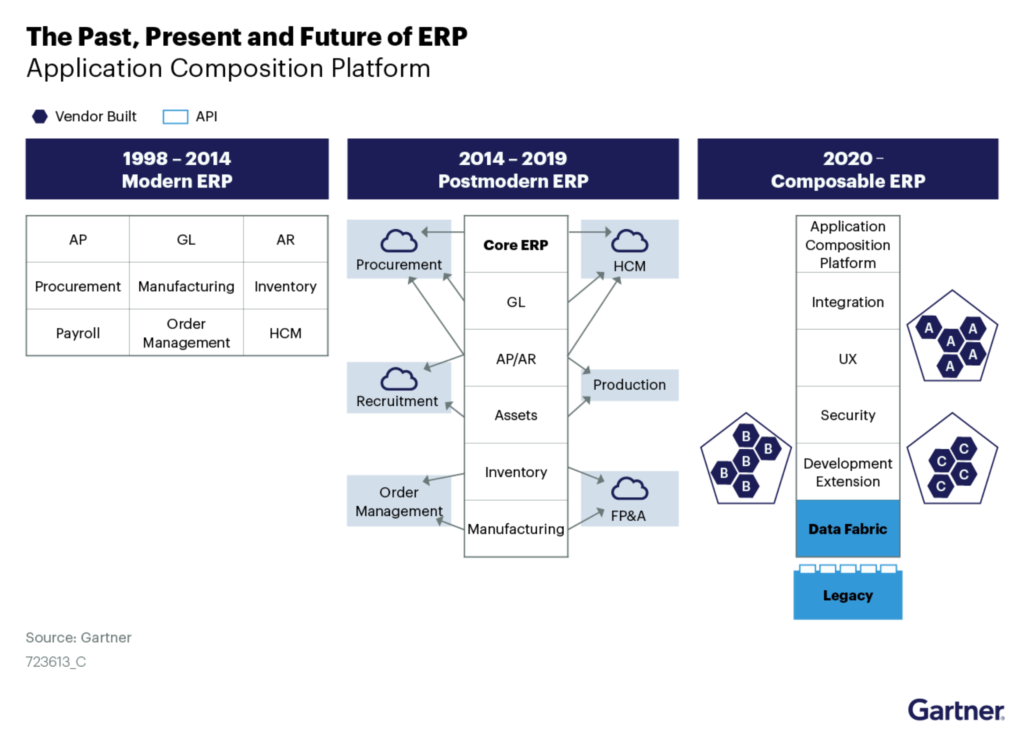Our clients often ask for help selecting an ERP software platform. This is not surprising given that Enterprise Resource Planning (ERP) is no longer a choice for enterprises; it’s a necessity. ERP software, used primarily by HR, Finance and Supply Chain departments, has historically been implemented to produce business process efficiencies and centralize data. However, ERP functionality is continuously evolving to deliver everchanging advances in technology. It is now common for ERP platforms to offer mobile capabilities, artificial intelligence, and superior analytics. Organizations have learned to embrace ERP, understanding the importance it plays in competitive advantage as well as overall enterprise effectiveness.
Despite all the advantages ERP offers, ERP implementations and ongoing support and maintenance have gained a reputation for being cumbersome, convoluted, and arduous. Various contributing factors play into this outcome. Rigid ERP functionality did not allow organizations to easily reshape and standardize business processes, forcing unsupported customizations to be developed. Organizations were required to staff a department of technical experts to implement and maintain ERP platforms not only because of the complex configuration model and customizations, but also because of on-premise infrastructure and databases. Insufficient employee training and change management has also played a key role in reducing the overall organizational satisfaction with its ERP initiatives.
Best practice ERP strategy has recognized these challenges and continues to evolve. Gartner® has named ERP’s newest model ‘Composable ERP’. ‘Composable ERP is defined as an adaptive technology strategy that enables the foundational, administrative and operational digital capabilities enabling an enterprise to keep up with the pace of business change. This strategy delivers a core of composable applications and, as a service, software platforms that are highly configurable, interoperable and flexible to adapt to future modern technology (see Figure 1).’ [1]

The rigid structure of Modern ERP that made it challenging for organizations to standardize processes and quickly adapt to changing requirements has been replaced by a more agile model that supports a core ERP platform for critical business processes mixed with specialized software solutions for other business processes. This model promotes a variety of applications to be utilized, allowing enterprises to take advantage of ‘best of breed’ technology. In addition, ERP software has started tailoring configuration to business users instead of IT. This allows the business to assume more ownership of the application while allowing IT to focus on integrations and security.
Composable ERP takes it a step further by promoting a cloud based, vendor agnostic architecture to meet organizational requirements. This could be any combination of ERP suites and ‘best of breed’ solutions within multiple clouds. Business capabilities must be defined and then the composable architecture can be utilized to determine which application(s) fulfill those strategic requirements. As with Postmodern ERP, Composable ERP relies heavily on a strong integration strategy to ensure the various systems are passing data accurately and efficiently. Lackluster integrations can be the downfall of an otherwise effective ERP implementation. Data must be consistent, pristine and available in a timely manner. Composable ERP promotes an architecture built for launching web services and leveraging APIs. APIs are then utilized to provide solutions for those pre-defined business capabilities.
Since it’s the newest approach, it may be tempting to simply assume Composable ERP is the best platform for an organization. However, there are several things to consider before jumping in. There must be a shift in the way organizations have historically thought about who owns the ERP strategy. The success of a Composable ERP architecture requires primary ownership by the business with IT playing a supporting role. Constant collaboration between the business leaders and IT leaders is necessary to ensure business strategies and ERP solutions are aligned, even after the solution has been implemented. Before any software solution is selected, a candid analysis of the organization’s current landscape, digital transformation roadmap, and future-state application architecture is crucial.
We focus on ensuring our clients are educated and positioned to take advantage of leading-edge ERP practices and strategies to keep pace with business changes, quickly deliver innovation and gain competitive advantages. Composable ERP is now at the forefront of ERP best practices. However, creating a successful ERP strategy is truly the foundation of success and should never be overlooked or underestimated.
[1] Gartner, The Future of ERP Is Composable, Tim Faith, Denis Torii, Paul Schenck, 13 October 2020
GARTNER is a registered trademark and service mark of Gartner, Inc. and/or its affiliates in the U.S. and internationally and is used herein with permission. All rights reserved.